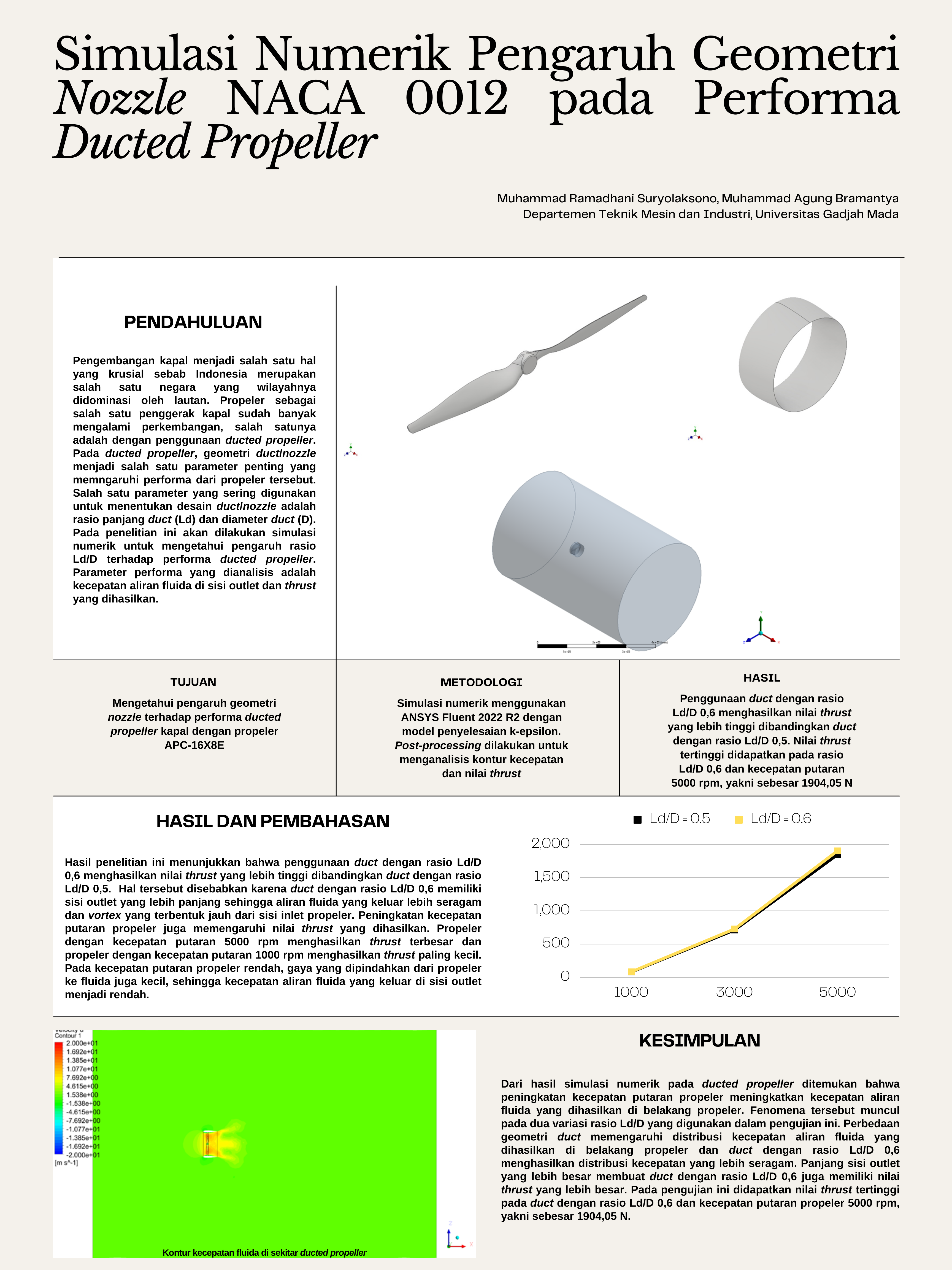Numerical Simulation of the Effect of NACA 0012 Nozzle Geometry on Ducted Propeller Performance
Simulasi Numerik Pengaruh Geometri Nozzle NACA 0012 pada Performa Ducted Propeller
DOI:
https://doi.org/10.21070/pels.v4i0.1381Keywords:
Ducted Propeller, Ld/D Ratio, Nozzle, Nuerical Simulation, ThrustAbstract
Ducted propeller is a method on the propeller modification which added duct/nozzle on the propeller. Ducted propeller application is aimed to increase propeller thrust, increase propeller efficiency, and decrease propeller noise and vibration. In this research, a numerical simulation was conducted using ANSYS Fluent 2020 R2 with k-epsilon solver model. The aim of this research is to analyze the effect of the duct geometry using Ld/D (duct length/duct diameter) ratio. The simulation was done on two Ld/D variations at three different propeller angular velocity (1.000, 3.000, 5.000 rpm). The result of this research shows that duct with 0,6 Ld/D ratio has higher thrust force than duct with 0,5 Ld/D ratio. Meanwhile, the increase of propeller angular velocity increase propeller thrust force and fluid velocity.
Downloads
References
[2] F. Ortolani, A. Capone, G. Dubbioso, F. Alves Pereira, A. Maiocchi, and F. Di Felice, “Propeller performance on a model ship in straight and steady drift motions from single blade loads and flow field measurements,” Ocean Engineering, vol. 197, Feb. 2020, doi: 10.1016/j.oceaneng.2019.106881.
[3] Y. C. Hsieh and D. M. Hai, “Computational study on the effect of the shape of ducts on the performance of the submarine propeller,” Advances in Mechanical Engineering, vol. 11, no. 8, pp. 1–10, 2019, doi: 10.1177/1687814019870902.
[4] M. Chen, J. Liu, Q. Si, Y. Liang, Z. Jin, and J. Yuan, “Investigation into the Hydrodynamic Noise Characteristics of Electric Ducted Propeller,” J Mar Sci Eng, vol. 10, no. 3, Mar. 2022, doi: 10.3390/jmse10030378.
[5] I. S. Arief, T. B. Musriyadi, and A. D. A. Je Mafera, “Analysis Effect of Duct Length– Nozzle Diameter Ratio and Tip Clearance Variation on the Performance of K-Series Propeller,” International Journal of Marine Engineering Innovation and Research, vol. 2, no. 1, 2017, doi: 10.12962/j25481479.v2i1.2527.
[6] W. Yue, R. Wanlong, L. Gang, Z. Yuanming, and H. Zongrui, “The Numerical Analysis of Hydrodynamic Characteristics of Ducted Propeller by using SST k-ω Model,” IOP Conf Ser Mater Sci Eng, vol. 649, no. 1, pp. 1–7, 2019, doi: 10.1088/1757-899X/649/1/012025.
[7] S. Yilmaz, D. Erdem, and M. S. Kavsaoglu, “Performance of a ducted propeller designed for UAV applications at zero angle of attack flight: An experimental study,” Aerosp Sci Technol, vol. 45, pp. 376–386, 2015, doi: 10.1016/j.ast.2015.06.005.
[8] B. Nopias, K. Muhajir, and T. Rusianto, “Pengaruh Gaya Dorong Propeler pada Engine Fora Terhadap Kecepatan Pesawat Model F2D Combat,” 2017. [Online]. Available: http://dle-tech.info/tag/pitch/
[9] E. Kuantama and R. Tarca, “Quadcopter thrust optimization with ducted-propeller,” in MATEC Web of Conferences, EDP Sciences, Oct. 2017. doi: 10.1051/matecconf/201712601002.
[10] F. Sihaloho, P. Manik, A. Wibawa Budi Santosa, and L. Perancangan Kapal Dibantu Komputer, “Analisa Nilai Thrust Ducted Propaller Dengan Variasi Diameter, Panjang & Tipe Kort Nozzle Menggunakan Metode CFD,” Jurnal Teknik Perkapalan, vol. 8, no. 3, 2020, [Online]. Available: https://ejournal3.undip.ac.id/index.php/naval




